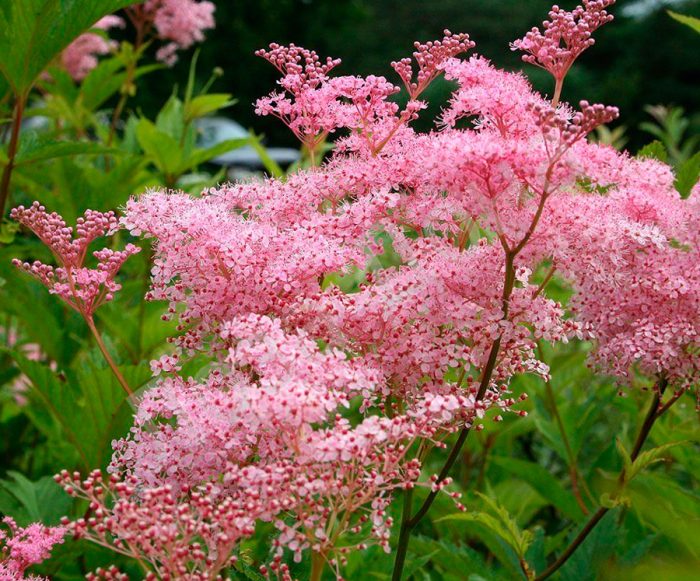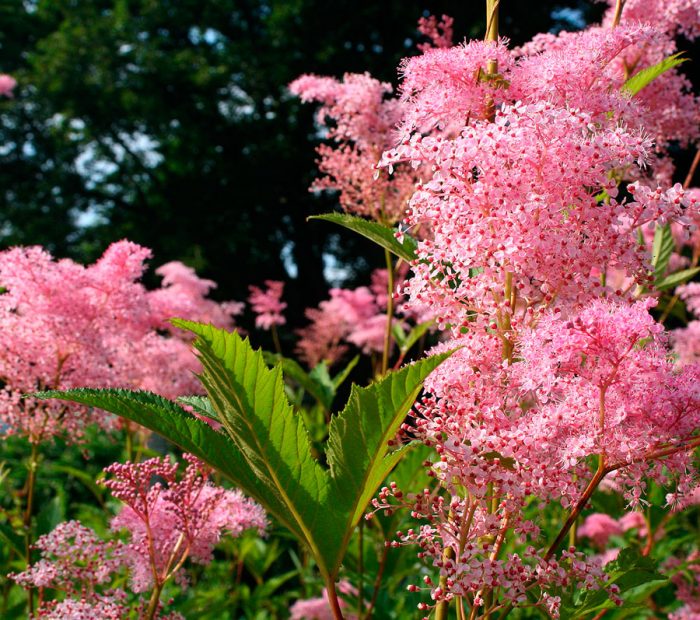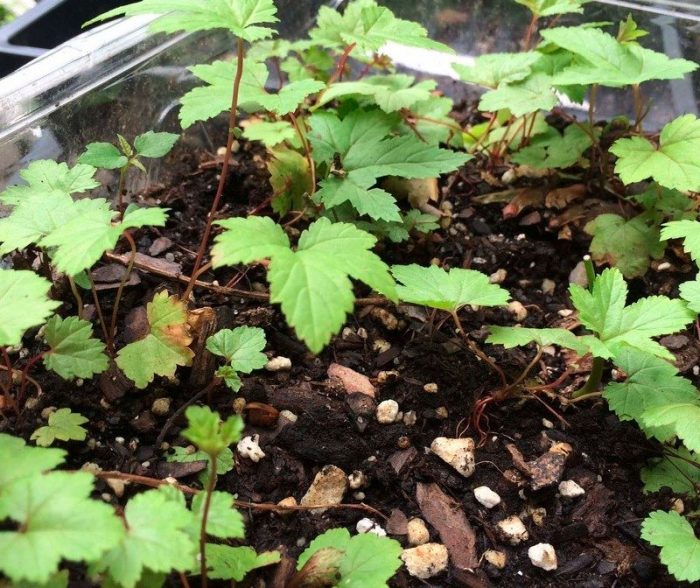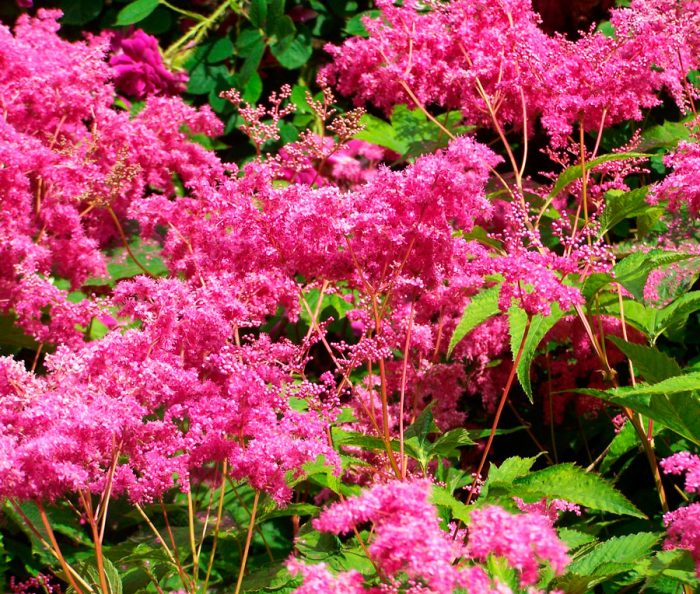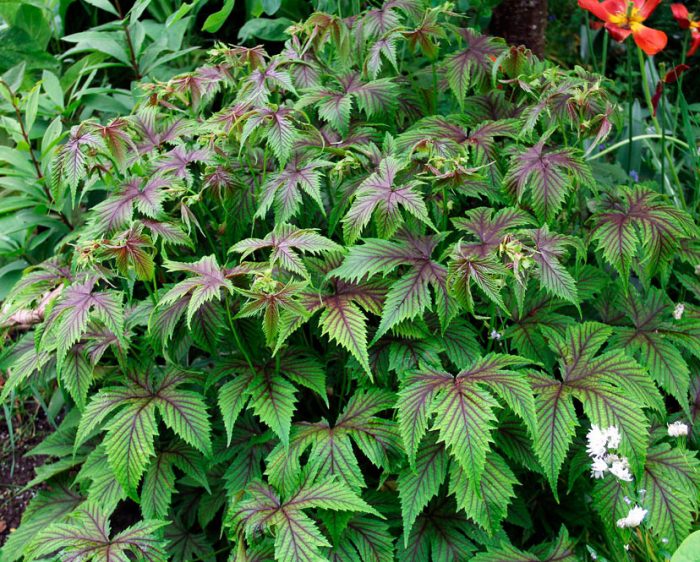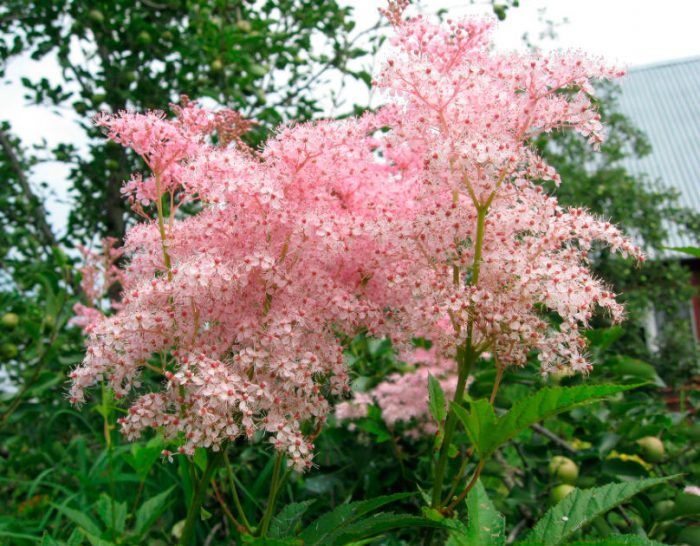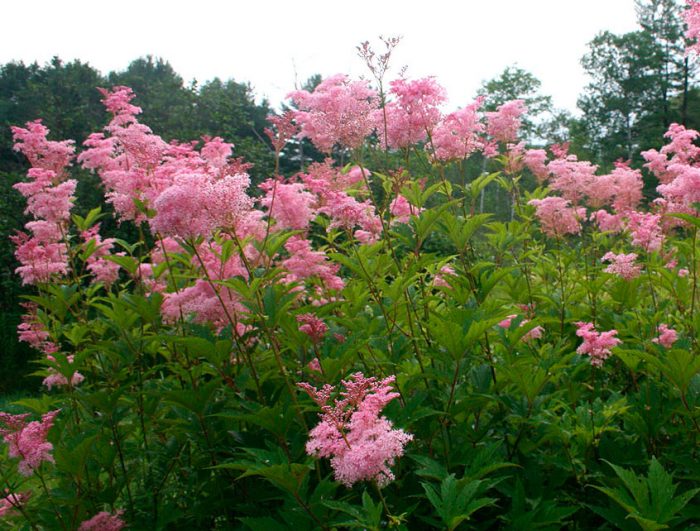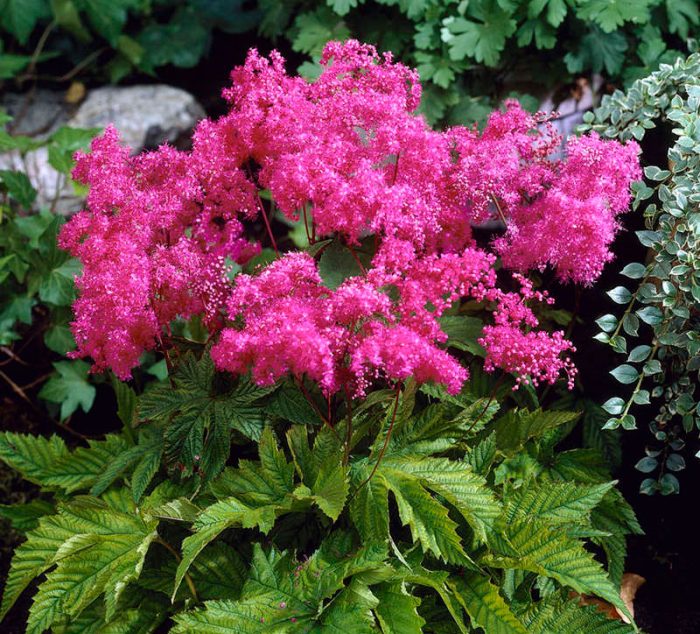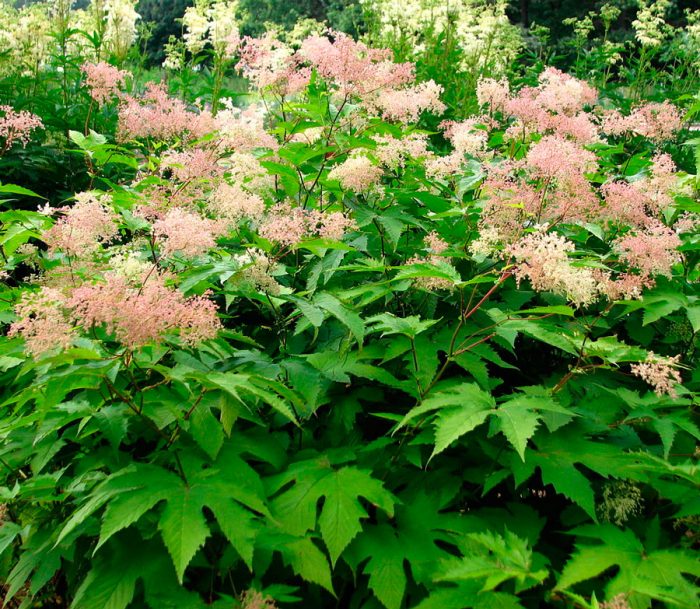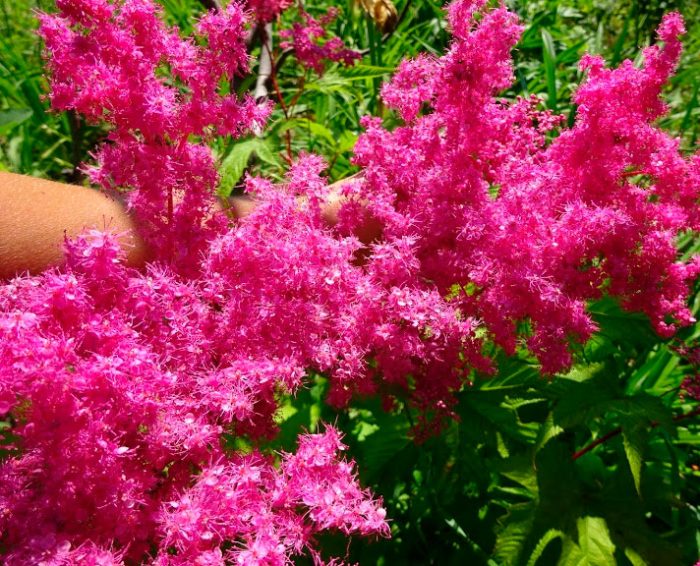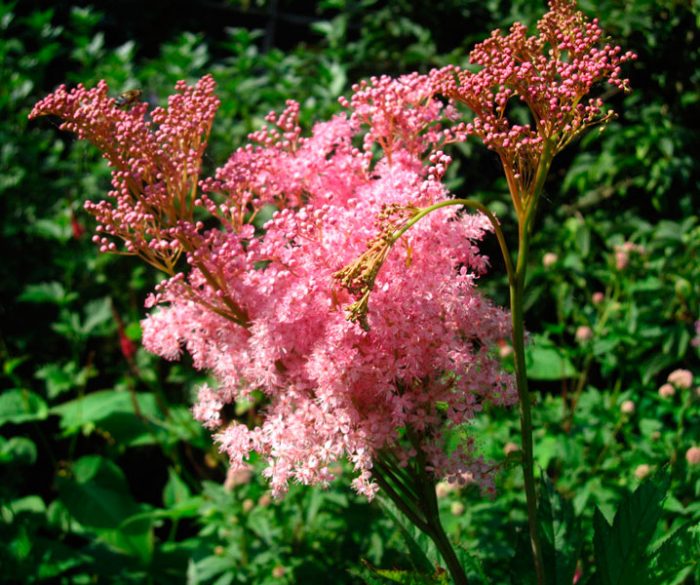Perennial shrub meadowsweet is a medicinal plant. However, gardeners grow it not only for this reason, but also because it has a high decorative effect.
Content
Features of the meadowsweet
The meadowsweet plant, also called meadowsweet, is a perennial shrub, the height of which can vary from 0.6 to 0.8 m. Its stem is erect. For a long time this plant was part of the Spirey genus. To date, it has been singled out as an independent genus, uniting several species.
During the flowering period, the bush is decorated with paniculate inflorescences, reaching about 15 centimeters in diameter. They consist of small (up to 10 mm in diameter) flowers of a pale yellow color. Externally, wide feathery leaf plates bear little resemblance to fern leaves. Since the foliage is large, it evaporates a large amount of water in the summer. There are species of meadowsweet in which the foliage dries up for a while on the hottest days, which allows the plant to reduce the volume of evaporated water. The bush has a short rhizome. For 12 months, the roots of this plant grow by only 20–30 mm in length. Fragrant flowers have an almond-honey aroma. Flowering begins in June and lasts for 6 weeks.
Under natural conditions, meadowsweet prefers to grow in swampy areas. Most often it can be found on the banks of water bodies. It also grows on mountain slopes, in the forest and in the meadow. In nature, the shrub can be found in the Caucasus, Asia, Siberia, and also in the temperate latitudes of Europe. The meadowsweet is able to form huge thickets, the length of which sometimes reaches hundreds of hectares.
Planting a meadowsweet in open ground
Seat selection
For growing meadowsweet in the open field, it is best to choose an area with moist soil, but at the same time water should not stagnate on it. In the event that the groundwater is very close to the surface of the site, then it is recommended to make a high bed for the shrub and not forget about the thick drainage layer.
An area suitable for such a plant may be slightly shaded. Please note that it cannot be grown in the shade.It is best for him to choose a sunny open place or an area that will only be slightly shaded by the plants growing nearby.
Priming
Meadowsweet is not particularly demanding on the composition of the soil. However, it grows best on neutral, nutritious soil. If the soil on the site is acidic, then before planting the shrub, it is recommended to add wood ash or lime to it. Also, during the digging of the site into the ground, it is advisable to add compost or humus.
The plant also prefers well-drained soil. Therefore, if the soil is heavy, then sand should be added to it.
Reproduction methods
Meadowsweet can be propagated in several ways: by dividing the bush, by seeds and part of the rhizome.
Growing from seeds
Meadowsweet seeds need natural stratification and hardening. That is why it is recommended to sow them before winter. To begin with, you need to remove all weeds from the site selected for sowing, after which it is moistened. The seeds of this plant are highly sensitive to light. In this regard, it is recommended to sow them in a shaded place (not in the shade). Later, the grown seedlings can be planted in a permanent place.
Seed material should be buried in the soil no more than 50 mm. Otherwise, the sprouts will not be able to break through the thick layer of soil. The distance between the seeds should be from 0.3 to 0.4 m. Thanks to such a rare planting, young plants will be able to grow and develop within normal limits, without interfering with each other.
The first seedlings should appear in the second half of April or in the first - May. They are very slow in growth. As a rule, up to five leaf plates are formed on each bush by the end of the season. In this form, they hibernate under the snow. For the first time, the bushes will bloom only in the second or third year of growth. In the event that the plant is in unsuitable conditions for growth, then it can bloom much later.
If desired, sowing seeds can be carried out in the spring. Before sowing, the seed needs to be prepared. To do this, it is immersed for some time in a solution of a growth stimulant, for example, Novosil or Zircon. Crops need timely and proper moisture, as well as shading, which can be artificial or natural. But even if you do everything right, be prepared for the fact that the seeds will not germinate during spring sowing.
Meadowsweet seeds remain viable, as a rule, for 6 years. However, the germination period can be significantly reduced, this is greatly influenced by the place of collection or cultivation.
If you still decide to sow meadowsweet in the spring, then keep in mind that the bushes that appear will grow extremely slowly, and their first flowering will not come earlier than in the third or fourth year of growth. Therefore, despite the fact that you sow meadowsweet in spring, it will bloom much later than the bushes that grew after winter sowing.
Dividing the bush
Propagation of meadowsweet by dividing the bush is more popular with gardeners than by seeds. You can divide the bush into parts in autumn, when it fades, or at the very beginning of spring - from March to April. When choosing the time for dividing the bush, it should be remembered that after the spring transplant, the meadowsweet will bloom later than after the autumn one.
Dig a bush out of the ground and divide its rhizome into several parts. It is recommended to plant the plots in the soil immediately after dividing. If you divided the plant in the fall, and you are going to plant the cuttings only in the spring, in order to preserve them, it is recommended to bury parts of the bush in moistened sawdust or ground.
When disembarking the divisions, a distance of at least half a meter should be maintained between them. They should be buried in the soil no more than 50 mm. In the fossa, the roots should be horizontal, with the pointed tips of the buds pointing up.Remember that there should be no weeds and plant debris near young bushes. Also, do not forget about good drainage and constant soil moisture. Delenki take root quite well, while they bloom much earlier than bushes grown from seeds.
Care of the meadowsweet
Watering
The meadowsweet grown in the open field needs timely and proper watering. Water the bushes abundantly, avoiding stagnation of liquid in the root system, as this can provoke the development of a fungal disease. On average, it is watered once every 7 days.
Top dressing
When growing meadowsweet in nutritious soil, you can do without top dressing. However, for better growth and lush flowering, experts advise, 1 or 2 times during the season to feed it with organic matter or mineral fertilizer (for example, potassium sulfate, superphosphate). Remember that a large amount of nitrogen cannot be applied to the soil, as this can cause the bushes to bloom much later.
Pruning
In order for the shrub to have a neat appearance all the time, do not forget to cut off the peduncles that have begun to fade in time. To do this, completely cut off the shoot that has faded, or pinch off the wilted inflorescence with your hands.
Wintering
The meadowsweet has a fairly high frost resistance. Shortly before the first frost, shorten all the stems of the bush to 50–100 mm. You do not need to cover it for the winter. However, if in your region severe frosts are frequent in winter, then after pruning it is recommended to cover the area with a layer of mulch about 10 centimeters thick, for this you can use compost or peat.


Watch this video on YouTube
Healing properties
In both official and folk medicine, meadowsweet is considered a medicinal plant that has antimicrobial and anti-inflammatory effects. It is popularly considered "a cure for forty diseases." This plant also has a pronounced anti-tumor effect, as well as the ability to strengthen the immune system. In folk medicine, meadowsweet is often used to treat flu and colds.
Also, this shrub is used to regulate acidity; for this, an infusion is prepared from the flowers, which helps to get rid of heartburn. And such an infusion also prevents the formation of blood clots in the blood vessels.
Types and varieties of meadowsweet with photo
In the open field, meadowsweet began to be cultivated as early as the 18th century. In total, 8 different species are cultivated as an ornamental plant. At the same time, only four types of meadowsweet are considered medicinal, namely: six-petal, palm-like, elm-leaved and Kamchatka. The roots, foliage and flowers of such a plant are considered healing. The most popular among gardeners is the meadowsweet or variegated meadowsweet. To decorate the garden, various types of meadowsweet are used, as well as a variety of varieties.
Elegans
This herbaceous compact plant is a perennial. Its height varies from 0.5 to 1 meter. The graceful leaf plates are deeply finger-cut and are green in color. During the flowering period, lush panicles are formed, consisting of small pinkish-purple flowers. This species blooms from June to August.
Umbrella
This variety is good because it has not only spectacular flowers, but also very beautiful foliage. In height, the bush can reach from 0.7 to 0.8 meters, and in diameter - up to half a meter. Finger-like leaves are greenish and have a serrated edge. This variety differs from the others in that the veins and the middle of its foliage are painted in a purple or dark brown hue. Long loose paniculate inflorescences consist of very small pink flowers. The plant blooms from July to September. However, it retains its high decorative effect throughout the season.
Pink
This garden form of pink meadowsweet is grown outdoors as a flowering plant.It is relatively rarely cultivated by gardeners. Experts believe that this plant is a hybrid of one of the rosaceous meadowsweet species. Inflorescences are painted in a pale pink shade.
Venusta
This is a variety of red meadowsweet. The plant reaches a height of about 170 centimeters. During flowering, lush inflorescences are formed at the tops of the shoots, which include flowers of a red-pink or pinkish-cream shade. The plant has a short rhizome. The bush grows many strong stems, which are decorated with feathery leaf plates, consisting of large-toothed lobes. Flowering lasts about a month and a half, and it is observed in July and August.
Magnifica
This plant is a variety of red meadowsweet. The formation of large lush inflorescences occurs at the ends of the stems, and they consist of flowers of a dark pink hue. The shrub can reach a height of about 170 cm. On powerful branching shoots, many green leaf plates grow, which have large lobes with a jagged edge. The bush blooms for about 1.5 months in July and August.
Variegated variegated
The shrub forms dense thickets, while the height of the stems can vary from 100 to 170 cm. Large pinnately dissected leaf plates consist of five or three-lobed lobes. The front surface of them is of a dark green hue, and is decorated with strokes and specks of yellow. The lower part of the foliage is painted in a paler shade. A very pleasant smell comes from the leaves. Powerful upright shoots are brownish-red. The horizontally arranged branching rhizomes as thick as a finger have many buds. In the summer, flowering stems are formed from them, which after a while form dense thickets.
Small flowers smell like honey, and they are painted in beige or white. Flowers consist of 5 petals and rather long stamens. The shrub blooms for 3–3.5 weeks in June and July. Lush panicles are 15 to 20 centimeters long. The bush looks spectacular only during the flowering period, and during the formation of the fruit, it turns into a dark shade. This plant is also popularly called white grass, meadowsweet, honeyberry, wet raspberry, whitehead, sorokopitochnik, meadowsweet, marsh honey.
Kamchatka, or silkworm
Under natural conditions, this species is found on the territory of the Kuril Islands, Kamchatka, Sakhalin, and also in the northern part of Japan. The height of such a vigorous plant can vary from 120 to 300 cm. Its thick rhizome is quite strong. On the surface of straight shoots there is pubescence, they are powerful and ribbed, painted in a pale red shade, and reach about 25 mm in diameter. Large broad-renal basal leaf plates are pinnate with shallowly palmate end lobes. The foliage reaches about 0.3 m in length, and about 0.4 m in width. The green shiny front surface of the leaves is smooth, and the back has a tomentose-hairy pubescence. Stem leaf plates are smaller, while those leaves that are located in the upper part of the shoot can be whole or three-lobed.
Large, loose corymbose inflorescences consist of fragrant cream or white flowers that reach about 8 mm in diameter. Bloom is observed in July and August. When the bush fades, its inflorescences become fluffy, as many oblong fruits ripen on them, the edge of which is densely covered with cilia. Fruits ripen in August.
Purple
This hybrid, which is highly decorative, is widely used in Northeast China, Japan and Korea. Every year it is gaining more and more popularity among gardeners in other countries. The height of the bush varies from 0.5 to 1 meter.Leaf plates of a green shade are deeply palmate incised into pointed segments of a lanceolate-ovoid shape, of which there are from 5 to 7 pieces. They have underdeveloped lateral processes. There are much more large basal plates than small stem plates. The panicles contain small flowers of a dark pink or purple hue. As a rule, the fruits are underdeveloped and stand out clearly on the petioles. They have cilia on the edge.
There is a garden form - Elegance. White flowers adorn the deep red stamens. The bush blooms from 3.5 to 4 weeks, approximately from the last days of June to August.
Red Venusta
This vigorous perennial forms large thickets. Large green, feathery leaf plates grow on shoots that can reach a height of 150–250 cm. Large lush panicles are collected from pinkish or pink small flowers. At the end of flowering, attractive raspberry-colored fruits are formed. Flowering lasts from 30 to 45 days and is observed in July and August. Grows well in well-lit open areas, as well as in the shade of large shrubs and trees. If the light is too poor, flowering may stop.
Palm-shaped
This variety is highly decorative, and it began to be cultivated in 1823. It forms dense, single-species thickets. The name of the variety is associated with large, palm-shaped leaf plates that look like the palm of a hand. Their seamy surface has a dense gray felt pubescence. The height of the stems is up to 100 cm. It differs from other species in that its rhizome is located in the soil at a greater depth. The length of the lush inflorescences is about 25 centimeters, they consist of a large number of very small flowers of a pale pink or white hue, which smell like honey. At the end of flowering, they become lighter. No more than eight paniculate inflorescences are formed on one plant. The bush blooms from 3.5 to 4 weeks in June and July.
In nature, the plant can be found in Eastern Siberia, Mongolia, the Far East, and also in China and Japan. It prefers to grow in bushes and forest meadows.
Six-petaled, or ordinary
The height of such a perennial can vary from 0.3 to 0.7 m. This species is the shortest, and it is also very popular with gardeners. In nature, he prefers to grow in fields, in clearings and forest edges, in forest-steppe, along rivers, in bushes.
This plant is valued for its thin cord-shaped rhizome with tuberous oblong-oval thickenings of dark color. At the very top, the stem is simple, erect, branching slightly. In the basal rosette, the stem is intermittently pinnate. The rosette consists of many deeply incised pinnately dissected or toothed leaf plates, while smaller leaves grow between them. The stem is covered with a small number of medium-sized leaf plates, which have serrated stipules of a semi-heart shape.
The lush panicles are about 15 centimeters long. They consist of white or pinkish-white flowers, reaching about 10 mm in diameter. Their petals are obovate. Blooms from June to July. The fruit contains from 9 to 12 hairy seeds, which are tightly pressed against each other. They ripen in July and August.
In alternative medicine, only rhizomes with thickenings are widely used. They are composed of tannins, vitamin C, goulterin glycoside and starch. Harvesting of raw materials is carried out in September and October, or in April (before the beginning of the growing season). Cut the tubers from the rhizomes removed from the soil and rinse them under running cold water. Spread them out on a flat surface in a cool, well-ventilated area. For storage, they are put in linen bags or paper bags. The shelf life is about three years. The dried roots have a tart, bitter taste.The raw material has anti-inflammatory, fixing, diaphoretic and diuretic effects. Decoctions and infusions are prepared from it, which help with inflammation of the bladder and kidneys, with skin diseases, and they are also used to improve the activity of the digestive tract.
Common meadowsweet captivity is a garden form of this species. White terry inflorescences are very fragrant. The plant has a height of about one and a half meters. Over time, the lower part of the stems is exposed. That is why such a plant is planted in the background of a flower garden. Flowering bushes are similar to "snow caps" because of the many large double paniculate inflorescences.


Watch this video on YouTube

